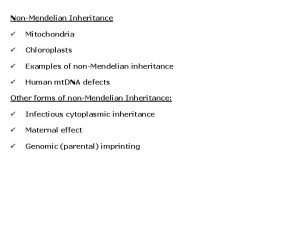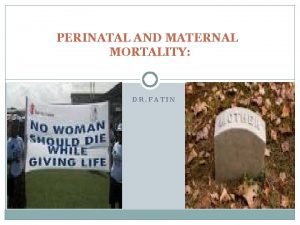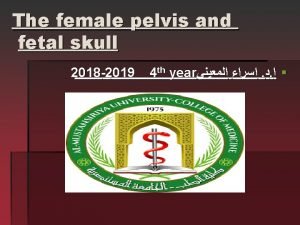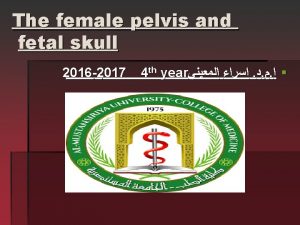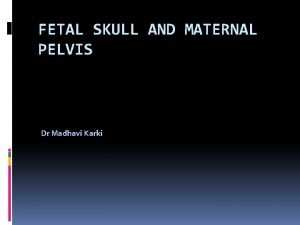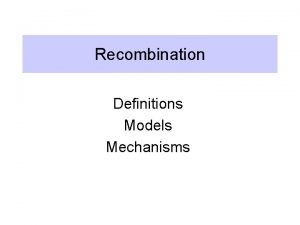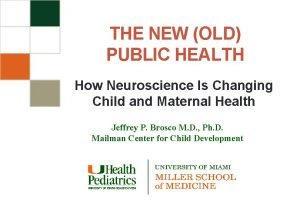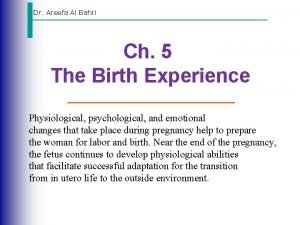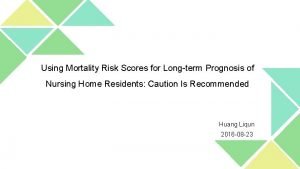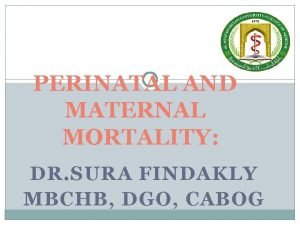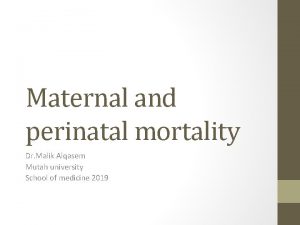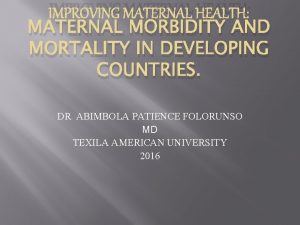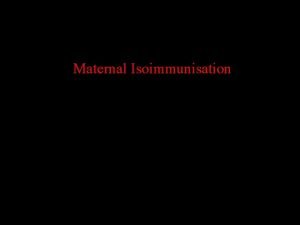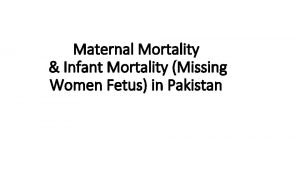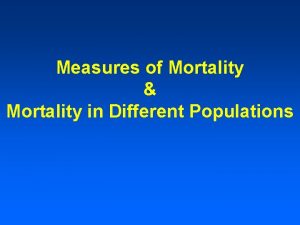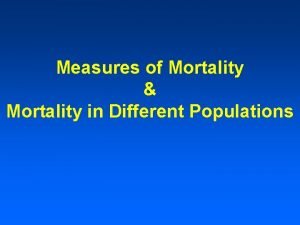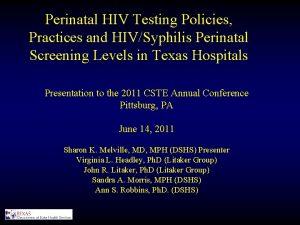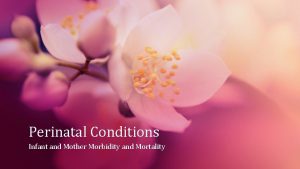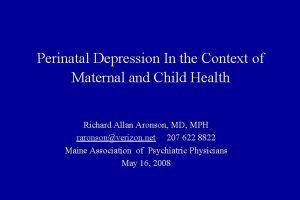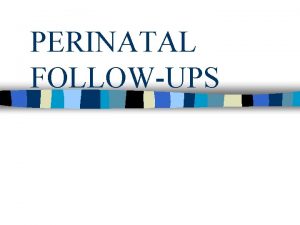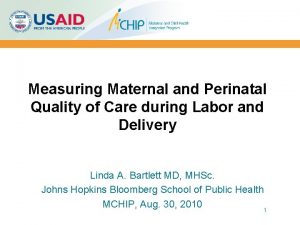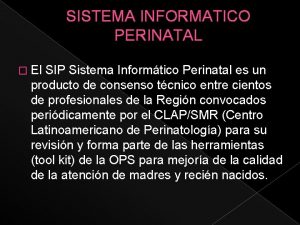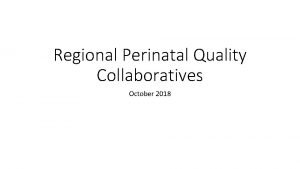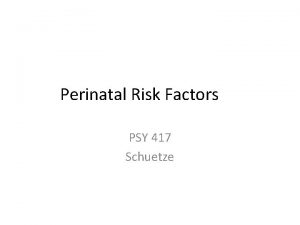PERINATAL AND MATERNAL MORTALITY DR FATIN Perinatal mortalityPNM






















- Slides: 22

PERINATAL AND MATERNAL MORTALITY: DR. FATIN

Perinatal mortality(PNM), also perinatal death, refer to the death of a fetus or neonate and is the basis to calculate the perinatal mortality rate. Variation in the precise definition of the perinatal mortality exist specifically concerning the issue of inclusion or exclusion of early fetal and late neonatal fatalities. The WHO definition is "number of stillbirth after 24 weeks and deaths in the first week of life per 1, 000 live births but other definitions have been used.

*preterm birth is the most common cause of perinatal mortality, causing almost 30% of neonatal deaths. Infant respiratory distress syndrome, in turn, is the leading cause of death in preterm infants, affecting about 1% of newborn infants. Birth defects cause about 21% of neonatal death.

FETAL MORTALITY: Fetal mortality refers to stillbirths or fetal death. It encompasses any death of a fetus after 20 weeks of gestation or 500 grams. In some definitions of the PNM early fetal mortality(week 20 -27 gestation) is not included, and the PNM may only include late fetal death and neonatal death. Fetal death can be divided into death prior to labour, antenatal(antepartum)death, and death during labour, intranatal (intrapartum) death.

NEONATAL MORTALITY: Early neonatal mortality refers to a death of a live-born baby within the first seven days of life, while late neonatal mortality cover the time after 7 days until before 28 days. The sum of these two represent the neonatal mortality. Neonatal mortality and postneonatal mortality(covering the remaining 11 months of the first year of life) are reflected in the infant mortality rate.

PERINATAL MORTALITY RATE: The PNMR refers to the number of perinatal deaths per 1, 000 total births. It is usually reported on an annual basis. It is a major marker to assess the quality of health care.

Cause of perinatal death: 1. spontaneous preterm labour(labour before 37 weeks gestation): - idiopathic(no obvious cause found) -preterm labour with chorioamnionitis. -preterm prelabour rupture of the membranes(with no obvious chorioamnionitis). -preterm prelabour rupture of the membrane(with obvious chorioamnionitis). -cervical incompetence.

2. infections: -syphilis. -amniotic fluid infection. -malaria. 3. antepartum haemorrhage: -abruptio placenta(without hypertension). -abruptio placenta(with hypertention). -placenta praevia.

. 4. intrauterine growth restriction(infant underweight for gestation age, usually with wasting and fetal hypoxia): -idiopathic (maternal underweight, smoking, alcohol, or a cause unknown but excluding hypertension). -postterm(gestation beyond 42 weeks). 5. hypertension: -proteinuric hypertension(pre-eclampsia). -chronic hypertension. -Eclampsia.

6. fetal abnormality: -. -subdivided into organ systems(e. g central nervous system). -multiple abnormalities(may be recognizable syndrome). -chromosomal abnormality(e. g Down syndrome). -non-immun hydrops. 7. trauma: -stuck breech (dies of hypoxia). -trauma due to assisted delivery(forceps or vacuum). -ruptured uterus. -motor vehicle accident or personal assault.

8. intrapartum hypoxia: -labour related(prolonged labour, cephalopelvic disprpportion, hypertonic uterus). -meconium aspiration. -cord prolapsed. -cord around the neck(3 or more times). 7. maternal disease: - diabetes mellitus. -cardiovascular. 10. unexplained intrauterine death.

MATERNAL MORTALITY: The systemic review found that the distribution of causes of maternal death varies by United Nation region. Heamorrhage , for example , is the leading cause of maternal mortality in Africa accounting for 34% of maternal deaths, and also in Asia, where it account for 31% of maternal deaths. In Latin Amerca and the Caribbean, hypertensive disorders, causing 26% of maternal death, top the list of causes in developed countries, the most important cause of maternal death is "other direct causes"(21%), which includes largely complications during interventions such as those related to caesarean section and anaesthesia, followed by hypertensive disorders and embolism.

Maternal death is defined by the WHO as : the death of women while pregnant or within 42 days of termination of pregnancy, irrespective of the duration and the site of the pregnancy, from any cause related to or aggravated by the pregnancy or its management, but not from accidental or incidental causes(WHO 1992). The definition includes deaths of women from pregnancy, termination of the pregnancy, spontaneous abortion, miscarriage and ectopic pregnancy, but it excludes deaths from assisted reproduction here pregnancy has not occurred.

Direct deaths result from obstetric complications of the pregnant state(pregnancy, labour and puerperium), from interventions, omissions or incorrect treatment, or from a chain of events resulting from any of the above. They are complications of the pregnancy itself example, eclampsia, amniotic fluid embolism, rupture of the uterus, postpartum hge). Indirect deaths result from pre-existing disease or disease that developed during pregnancy and was not due to direct obstetric causes, but which may have been aggravated by the physiological effects of pregnancy(for example, heart disease , diabetes, renal disease).

Incidental deaths result from conditions occurring during pregnancy, where the pregnancy in unlikely to have contributed significantly to the death, although it is sometime possible to postulate a distant association(for example, road accidents, malignancies). Late maternal deaths(defined as the death of a women from direct or indirect obstetric cause more than 42 days but less than 1 year after termination of pregnancy) have not been included in the analysis as they not been routinely collected in Australia until recently.

Morbidity: Hypertensive disorders of pregnancy. Stillbirth. Preterm delivery. Induced abortion. Haemorrhage(antepartum, intrapartum, postpartum, unspecified). Anaemia. Placenta anomalies(pravia, abruption, ect. ) Spontaneous abortion. Gestational diadetes. Ectoptic pregnancy. Premature rupture of membrane. Perinaeal laceration.

Obstructed labour. Depression(postpartum, during pregnancy) Puerperal infection. Violence during pregnancy. UTI. Malaria. Other conditions.

PRIMARY CAUSES OF MATERNAL DEATH: The most important subdivisions are: 1. abortion: -septic abortion. -uterine trauma. 2. ectopic pregnancy. 3. antepartum haemorrhage: -abruptio placenta with hypertension. -placenta praevia.

4. hypertensive disorders of pregnancy: -chronic hypertension. -proteinuric hypertension. -eclampsia. -HELLP syndrome. -ruptured liver. 5. pregnancy related sepsis: -amniotic fluid infection with ruptured membranes. -amniotic fluid infection without ruptured membranes. -puerperal sepsis following normal delivery. -puerperal sepsis following caesarean section.

6. non-pregnancy related sepsis: -AIDS. -pneumonia. -tuberculosis. -bacterial endocarditis. -pyelonephritis. -malaria. 7. pre-existing maternal disease: -cardiac disease e. g rheumatic valve disease. -endocrine e. g diabetes. -CNS e. g epilepsy. -skeletal e. g kyphoscoliosis.

8. postpartum haemorrhage: -retained placenta. -uterine atony. -ruptured uterus. -inverted uterus. 9. anaesthetic complication. 10. embolism. 11. acute collapse –cause unknown. 12. non obstetric cause. -motor vehicle. -assault. -suicide.

THANK YOU
 Transovarial transmission คือ
Transovarial transmission คือ Maternal effect and maternal inheritance
Maternal effect and maternal inheritance Fatin organ
Fatin organ Dr fatin a. sahhar
Dr fatin a. sahhar Fatin hamama
Fatin hamama Fatin abbas
Fatin abbas Morbidity and mortality
Morbidity and mortality National health programmes related to child health
National health programmes related to child health Prophase
Prophase History of maternal and child health
History of maternal and child health Mch indicators full form
Mch indicators full form Maternal and child malnutrition
Maternal and child malnutrition Chapter 15 maternal and fetal nutrition
Chapter 15 maternal and fetal nutrition Diameters of fetal skull
Diameters of fetal skull Asynclitic
Asynclitic Normal laber
Normal laber N
N Mentobregmatic
Mentobregmatic Holliday junction
Holliday junction Jama 2017
Jama 2017 Fetal station
Fetal station Flacker mortality score
Flacker mortality score Theme of death in the great gatsby chapter 4
Theme of death in the great gatsby chapter 4
